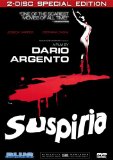Dario Argento’s film Suspiria is a pillar in the horror film genre. Argento has crafted an aesthetically disturbing film with his use of color and violence. What separates Argento’s body of work from other directors is his disregard for the normal conventions of narrative cinema. By constantly disorienting the audience with unmotivated long shots and graphic violence, Argento never lets the viewer get comfortable.
The violence that Argento uses frequently in his career makes his films stand out. In Suspiria, the score during the credits exemplifies the agitation that the viewer will endure throughout the film. This is why Argento comes back to the score over and over again. After the first murder, the audience is now cognizant of the brutality that Argento is famous for. In the book Mirrors/Broken Minds: The Dark Dreams of Dario Argento Maitland McDonagh discusses Argento’s infatuation with violence: “Argento murders and maims and splatters blood with abstract abandon, reveling in the mayhem with glorious unselfconsciousness; he is a hedonist who finds his pleasures in unacceptable places and has no compunction about letting everyone in on the fun.” What McDonagh is establishing is Argento’s awareness of the violence in his films and even though it may be construed as a crutch in the over used sense, Argento could care less. In Suspiria, each incident of violence plays an essential role in Argento’s vision. An example of this is when Sarah (Stefania Casini) is being chased throughout the dance studio and the audience gets an opportunity to see all of the lush colors and skewed camera angles that Argento uses. Once Sara has served her purpose, Argento disposes of her with a graphic zoom in of a throat being gouged open. Most directors would cut away; however, Argento zooms in and disrupts the viewer with the grotesque image. In all of Dario Argento’s works, the constant reoccurring trait is violence.
Argento effectively uses set design throughout Suspiria. The dance studio that the film operates within is peculiarly painted and maze-like with Argento being the only person who knows how to navigate through it. There are several extended tracking shots that follow the dancers through the studio. The film primarily takes place in the studio, but one the most explicit examples of the tracking shots is at the beginning of the film. Argento frames the two women with each shot, starting with the window and culminating with the door. Argento establishes the vulnerability of these female characters by using long shots and having them in their night gowns. The scene finally culminates with the stabbing of one woman and the impaling of the other. Argento has created a scene that is infamous for its effective use of mise-en-scène as well as shot selection.
The film succeeds in telling a story in a perplexing non-linear way. The overall narrative serves little to no function whatsoever. However, the audience is experiencing something unlike any other horror film, an overwhelming sense of excess. The colors, music and editing are all extremely excessive. Dario Argento compiles all of these things to disorient the viewer further and trap them in his bizarre universe of obtuse meaning. If you have not had the pleasure of seeing the film, do yourself a favor and rent it. Enjoy the season while it lasts.


